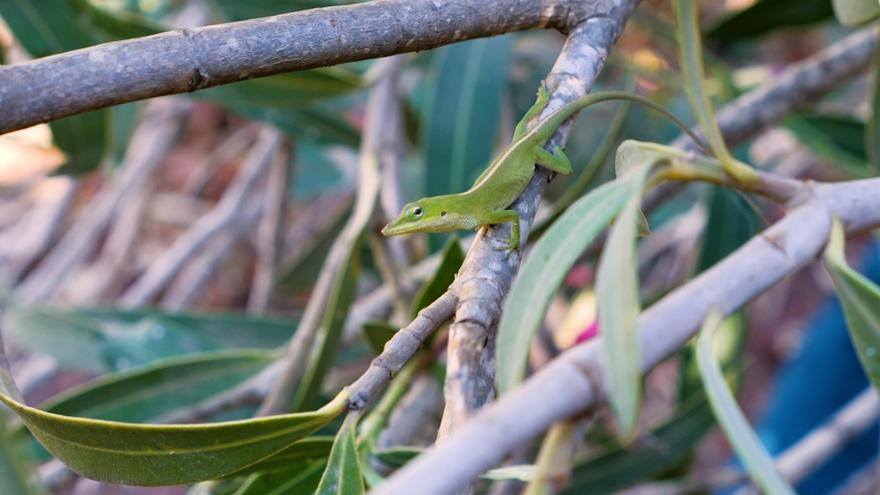
The Ministry of Ecological Transition, Fight against Climate Change and Territorial Planning of the Canary Islands Governmentin collaboration with staff from the Council of Tenerifethey have captured more than 1,500 specimens of the exotic green anole lizard.
The Ministry has recently presented to the Cabildo the results of the work of population control of this exotic lizard, made by technicians from the Biodiversity Service Y Gesplan and in which the Institute of Tropical Diseases and Public Health of the Canary Islandswithin the framework of the collaboration agreement between the University of La Laguna and the Government of the Canary Islands.
The regional councilor responsible for the Area, Jose Antonio Valbuenaencouraged the population to continue collaborating in the detection of exotic species: “Citizen notifications are essential for the early detection of new outbreaks and the control over them carried out by the Early Warning Network of the Canary Islands for the Detection and Intervention of Invasive Alien Species (RedExos)”.
For his part, the Deputy Minister for the Fight against Climate Change and Ecological Transition, Miguel Ángel Pérez, explained that the capture data confirms that the work has been carried out at an appropriate time to control an expanding population on the island of Tenerife.
“The proliferation of invasive alien species in our territory constitutes a serious threat to our endemic fauna”has indicated the Minister of Management of the Natural Environment and Security of the Tenerife Council, Isabel García.
He added that the effort made by administrations to control these species “must be supported with the collaboration of citizens, identifying and notifying the presence of unknown animals in the environment and, of course, not increasing exotic pet ownership that can invade our natural spaces”.
Among the conclusions obtained from the control work carried out, it can be deduced that the green anole, not only could be harmful to people for contain pathogens transmissible to humansbut also for the Canarian biodiversitysince they are arboreal animals that compete directly for the same resources as birds and perenquenes.
Early detection is essential to stop the expansion of this and other exotic species, since it allows to control the population when it is in the first levels of invasion. For this reason, the Government of the Canary Islands requests the collaboration of citizens to contact ReDExos through its mobile application, the telephone 646 601 457 or via email [email protected]where they will be informed of the steps to follow in case of detecting a specimen.
The ‘false chameleon’
The green anole (anole carolinensis) is a species of lizard belonging to the genus anole of the family Polychrotidae. This reptile is also known as false chameleon either north american chameleon, since it has the ability to change the color of its skin (it is said that when an anole shows a brown color, it is stressed). The species was documented in North Carolina (United States), therefore, the second word of its scientific name is “carolinensis“.
Green anoles habitat includes trees and bushes, walls, and wooded regions. Generally, their preference for high places is a way of protecting themselves from stalking predators. The green anole also inhabits urban and suburban areas, being very common on building facades and fence posts. Green anoles feed mainly on insects, including beetles, flies and mosquitoes, although they can also eat spiders and small arthropods, molluscs, seeds and grains. About 50% of the prey that this lizard captures occurs through a wait-and-see method, which allows it, once food is close, to pounce on it.
The main characteristics of the green anole are the following:
- It is an arboreal animal that lives in forests and savannahs full of vegetation. We can also find it among the rocks or hidden among the wood near the houses.
- Climb to the tops of trees to escape predators and to get food.
- Its diet is carnivorous, it feeds mainly on insects.
- It is easy to see the Green Anole basking in the sun on walls or branches.
- It is capable of changing color, going from green to brown and vice versa. This can be caused by a change in mood (stress or anger), by a variation in temperature or by the type of terrain in which it is found (to camouflage itself from the eyes of predators).
- Their life expectancy is between 4 and 8 years.
- An adult specimen is about 20 cm long, including the tail.
- Males have a fan-shaped fold of skin under their necks that they unfurl for courtship or fighting.
- It is an animal of diurnal habits.
- His character is very calm, especially that of the females. The males are aggressive towards each other.
- To hunt its prey, the green anole waits quietly (and camouflaged) until it approaches, that is, it hunts passively.
- The green anole is a very fast animal capable of quickly climbing trees to escape predators.
- In addition to being fast, this lizard has another defense mechanism: it can detach its tail if it needs to. In a few weeks, this appendage will completely regenerate.
- It is a territorial animal. In fact, if we place it in front of a mirror, the green anole can face its own reflection.
- These reptiles are very curious, they like to explore and they are not usually afraid of people.















